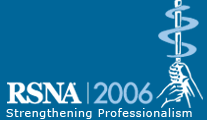
Abstract Archives of the RSNA, 2006
Masayuki Kudo, Presenter: Employee, General Electric Company
Takamichi Murakami MD,PhD, Abstract Co-Author: Nothing to Disclose
Masatoshi Kudo MD,PHD, Abstract Co-Author: Nothing to Disclose
Akira Hagiwara MS, Abstract Co-Author: Employee, General Electric Company
Koji Yamada, Abstract Co-Author: Nothing to Disclose
Akihiko Nishide BS, Abstract Co-Author: Employee, General Electric Company
Saori Kubo BS, Abstract Co-Author: Employee, General Electric Company
Paul Licato MS, Abstract Co-Author: Employee, General Electric Company
Yukinobu Yagyu MD, Abstract Co-Author: Nothing to Disclose
et al, Abstract Co-Author: Nothing to Disclose
To evaluate clinical benefit of CT angiography of abdominal vessel obtained by using non-stop continuous helical shuttle scan (CHSS) technique.
CT angiography examination was performed in seven patients with hepatocellular carcinoma (HCC) with 64 channel MDCT (LightSpeed VCT, GE Healthcare)
10 sec after an initiation of 100ml of contrast material was injected intravenously at a rate of 5ml/sec,18 phase helical CT images in the 160mm scan range were obtained during the 30 sec of breath-hold with a newly developed scan cradle that could rapidly move back-and-forth continuously. The temporal resolution of one phase scan was about 1.6sec. Scanning parameters were 40mm of X-ray beam width, 120kV, 0.4sec/rot.,150-200mA, 0 (stable) to 1.375(max) of Helical Pitch, and 0.625mm of slice thickness. From each phase data, MIP/VR images were reconstructed, and the visualization of the vessel were compared with DSA by three radiologists. Evaluation were done in 3 grade, 3:Good, 2:Fair, 1:Poor.
CT angiography with CHSS technqiue showed the same visibility of main abdominal vessels as DSA. Because CT angiography with CHSS technqiue enableed us to observe in three-dimensional, we could easily understand the anatomy of each vessel and the anatomical relationship between tumor and vessels better than DSA. Moreover, we could not only find feeding artery of the tumor or get morphologic information of vessel and tumor but also see dynamic blood flow. We could identify the flow direction of the each vessel by reconstructing continuous MIP/VR image of base image, artery, and vein. By using the CHSS technqiue , we were able to scan wide range continuously in a short time with MDCT.
4D MDCT enable us to get sequence of blood flow information from arterial to venous phase in three-dimensional and in time course so it is very useful for liver study. By using CHSS technique, we could get both morphological and hymodynamic in abdominal area in 4D MDCT Angiography.
Combined with 40mm detector coverage, this adaptive acquisition technique enables high coverage 4D CTA applications. CHSS enables us to collect special information from sequential data as DSA.
Kudo, M,
Murakami, T,
Kudo, M,
Hagiwara, A,
Yamada, K,
Nishide, A,
Kubo, S,
Licato, P,
Yagyu, Y,
et al, ,
Assessment of 4D MDCT Abdominal Angiography by Using Non-stop Continuous Helical Shuttle Scan Technique. Radiological Society of North America 2006 Scientific Assembly and Annual Meeting, November 26 - December 1, 2006 ,Chicago IL.
http://archive.rsna.org/2006/4436503.html

